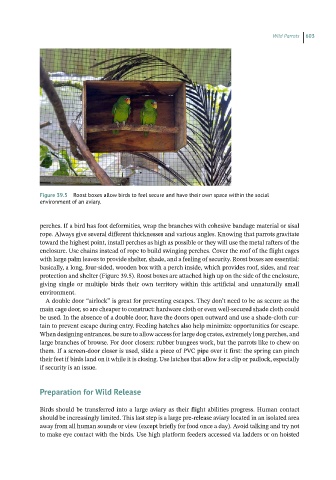Page 602 - Hand rearing birds second
P. 602
Wild Parrots 603
Figure 39.5 Roost boxes allow birds to feel secure and have their own space within the social
environment of an aviary.
perches. If a bird has foot deformities, wrap the branches with cohesive bandage material or sisal
rope. Always give several different thicknesses and various angles. Knowing that parrots gravitate
toward the highest point, install perches as high as possible or they will use the metal rafters of the
enclosure. Use chains instead of rope to build swinging perches. Cover the roof of the flight cages
with large palm leaves to provide shelter, shade, and a feeling of security. Roost boxes are essential:
basically, a long, four‐sided, wooden box with a perch inside, which provides roof, sides, and rear
protection and shelter (Figure 39.5). Roost boxes are attached high up on the side of the enclosure,
giving single or multiple birds their own territory within this artificial and unnaturally small
environment.
A double door “airlock” is great for preventing escapes. They don’t need to be as secure as the
main cage door, so are cheaper to construct: hardware cloth or even well‐secured shade cloth could
be used. In the absence of a double door, have the doors open outward and use a shade‐cloth cur-
tain to prevent escape during entry. Feeding hatches also help minimize opportunities for escape.
When designing entrances, be sure to allow access for large dog crates, extremely long perches, and
large branches of browse. For door closers: rubber bungees work, but the parrots like to chew on
them. If a screen‐door closer is used, slide a piece of PVC pipe over it first: the spring can pinch
their feet if birds land on it while it is closing. Use latches that allow for a clip or padlock, especially
if security is an issue.
Preparationfor WildRelease
Birds should be transferred into a large aviary as their flight abilities progress. Human contact
should be increasingly limited. This last step is a large pre‐release aviary located in an isolated area
away from all human sounds or view (except briefly for food once a day). Avoid talking and try not
to make eye contact with the birds. Use high platform feeders accessed via ladders or on hoisted

